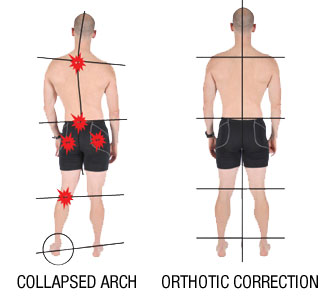Lower back pain is a prevalent issue affecting people of all ages and lifestyles. It can be caused by various factors, including poor posture, muscle strain, injury, and underlying medical conditions. Dealing with lower back pain can be challenging, but there are several effective strategies to promote healing, alleviate discomfort, and prevent future occurrences.
Seek Professional Medical Advice From Your Trusted Physiotherapist
.A qualified physiotherapist can assess the underlying cause of the pain and provide a proper diagnosis. In this article, we will explore a range of methods that can help individuals on their journey to heal lower back pain and regain their quality of life.
Custom Orthotics
The body assessment image shows how imbalances in the feet can lead to knee rotation, pelvic tilt and shoulder drop. These imbalances in the body can be caused by pronation and supination of the foot.
These instabilities can lead to conditions such as plantar fasciitis, knee pain, hip pain, back pain, and neck pain.

Custom foot orthotics can help correct all of the foot components that contribute to your back discomfort, including structural deficiencies, restricted range of motion, laxity in connective tissue, and limb length variances. Orthotics are only effective at reducing back pain if they address all of these flaws.
Apply Ice and Heat Therapy
In the initial stages of back pain, applying ice packs to the affected area can help reduce inflammation and numb the pain. After a couple of days or once the inflammation has subsided, alternating with heat pads or taking warm baths can promote muscle relaxation and alleviate tension.
Exercise and Physiotherapy
Engaging in regular, low-impact exercises and physical therapy can significantly contribute to healing lower back pain. Strengthening core muscles and the muscles surrounding the lower back can provide additional support to the spine, reducing strain and discomfort. Physical therapists can design targeted exercises tailored to your condition and help you correct posture and movement patterns that may contribute to the pain.
Gentle Stretching
Incorporate gentle stretching exercises into your daily routine to improve flexibility and reduce muscle tension in the lower back area. Focus on stretching the hamstrings, hip flexors, and lower back itself, but avoid aggressive or jerky movements that might exacerbate the pain.
Maintain Proper Posture
Maintaining good posture is crucial in preventing and healing lower back pain. Whether sitting or standing, ensure that your spine is properly aligned, and use chairs with adequate lumbar support. Consider ergonomic adjustments to your workspace to reduce strain during long periods of sitting.
Weight Management
Excess weight can put additional stress on the lower back, leading to increased pain and discomfort. Maintaining a healthy weight through a balanced diet and regular exercise can significantly relieve pressure on the spine and promote healing.
Practice Safe Lifting Techniques
Proper lifting techniques are crucial in preventing back injuries. Always use your legs, not your back, when lifting heavy objects, and avoid twisting while lifting. Keep the object close to your body to minimize strain on the lower back.
Optimize Sleep Environment
Invest in a comfortable mattress and pillows that provide adequate support for your spine while sleeping. Sleeping in a position that aligns your spine can promote healing and alleviate back pain.
Consider Massage Therapy
Massage therapy can be a valuable addition to your healing journey. Skilled massage therapists can apply techniques that reduce muscle tension, improve blood circulation, and promote relaxation in the lower back region.
Stress Management
Chronic stress can contribute to muscle tension and worsen lower back pain. Incorporate stress-reducing techniques such as meditation, deep breathing exercises, yoga, or mindfulness practices to alleviate emotional and physical stress.
Dry Needling
- Pain Relief: Dry needling can help reduce pain by deactivating trigger points and promoting the release of endorphins, the body’s natural pain-relieving chemicals.
- Muscle Relaxation: The insertion of needles into tight muscles can cause a reflexive relaxation response, reducing muscle tension and stiffness in the lower back area.
- Improved Blood Flow: Dry needling may enhance blood circulation to the affected area, promoting the delivery of oxygen and nutrients, which aids in the healing process.
- Increased Range of Motion: By releasing tension and improving muscle flexibility, dry needling can contribute to an increased range of motion in the lower back, enhancing mobility.
Seek Professional Medical Advice From Your Trusted Physiotherapist
.A qualified physiotherapist can assess the underlying cause of the pain and provide a proper diagnosis. In this article, we will explore a range of methods that can help individuals on their journey to heal lower back pain and regain their quality of life.
Always consult your physiotherapist for a proper assessment and evaluation.
Interested in learning more about this treatment- feel free to reach out at don@donkellypainrelief.com or you can give me a ring 089 273 4307
My treatment plan is the result of my experience and knowledge in treating chronic pains and injuries over the last 20 years. This is the holistic plan to guarantee pain relief, prevent recurring pains, and faster recovery.
EVALUATION/ASSESSMENT
PHYSIOTHERAPY PLAN BASED ON MY ASSESSMENT
HOMECARE EXERCISE/PLAN
ACUPUNCTURE
EXERCISE PROGRAMME
DRY CUPPING/DRY NEEDLING
MASSAGE
Low Back Pain Treatment Plan


